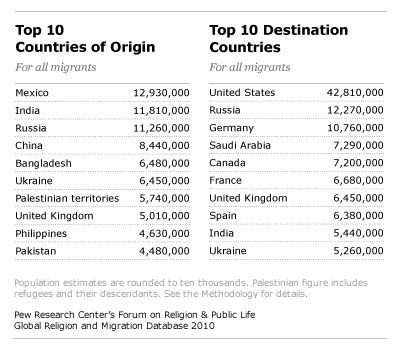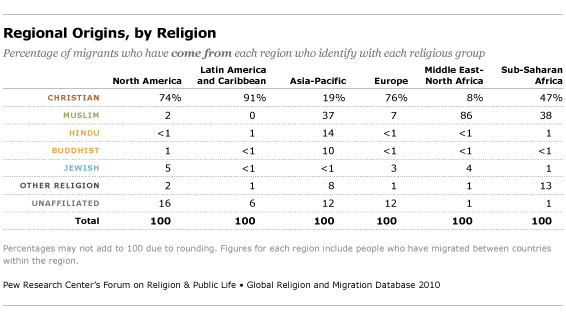 This report begins where all international migrants begin – in their home countries. More than 77 million migrants, or about 36% of the worldwide total, have come from the 10 leading origin countries.
This report begins where all international migrants begin – in their home countries. More than 77 million migrants, or about 36% of the worldwide total, have come from the 10 leading origin countries.
Overall, Mexico has been the largest single source of migrants (12.9 million), followed closely by India (11.8 million) and Russia (11.3 million). In addition, China (8.4 million), Bangladesh (6.5 million) and Ukraine (6.5 million) each have more than 6 million emigrants. Because the United Nations counts both Palestinian refugees and their descendants as migrants, the Palestinian territories have been the source of 5.7 million migrants, by the U.N.’s definition. The United Kingdom, the Philippines and Pakistan round out the Top 10 list of countries of origin for international migrants alive today.

About 110 million migrants, or more than 50% of the global total, have gone to the 10 leading destination countries. With nearly 43 million foreign-born residents, including more than 11 million unauthorized immigrants, the U.S. has more than three times as many international migrants as any other single country.2 Indeed, the U.S. has about as many immigrants as Europe’s top five destinations – Russia (12.3 million), Germany (10.8 million), France (6.7 million), the United Kingdom (6.5 million) and Spain (6.4 million) – combined.3
Levels of Migration, by Religion

Of the seven groups examined in this report, Jews have by far the highest overall level of international migration, in percentage terms. About one-quarter of Jews alive today have left the country in which they were born. Yet because Jews make up only a sliver of the world’s population – roughly 14 million out of a total of 6.9 billion people in 2010 – they represent a small fraction (about 2%) of all international migrants.4
By contrast, only one-in-twenty Christians alive today (5%) have emigrated from their country of birth. But because there are nearly 2.2 billion Christians around the world, that translates to nearly half of the world’s 214 million international migrants. Muslims make up the second-largest share of all migrants – almost 60 million
migrants, or a little more than a quarter of all international migrants. Only a small percentage (1-2%) of all Hindus, Buddhists and adherents of other faiths have migrated across borders.
The rest of international migrants (about 19 million) are unaffiliated with any particular religion.
Regional Patterns
The vast majority of people who have emigrated from their native countries in North America, Latin America (including the Caribbean) and Europe are Christians. And, not surprisingly, emigrants from most countries in the Middle East and North Africa overwhelmingly are Muslims. But emigrants from the remaining two regions – Asia-Pacific and sub-Saharan Africa – are more religiously mixed.
A plurality of migrants from Asia and the Pacific are Muslims (37%), but a substantial share are Christians (19%), Hindus (14%), unaffiliated (12%) or Buddhists (10%), reflecting the diverse mix of religions in that vast region. Meanwhile, more than eight-in-ten emigrants from sub-Saharan Africa are either Christians (47%) or Muslims (38%).
In general, the religious affiliation of immigrants to each region is similar to the religious affiliation of emigrants from that region. For example, most migrants who have moved to countries in North America are Christians. This includes large numbers of people who have migrated from Latin America to the United States. The result is that in North America as a whole, Christians make up the vast majority both of emigrants (74%) and of immigrants (72%).
There is more of a disparity between emigrants and immigrants in Europe. While roughly three-quarters of the people who have left European countries are Christians (76%), a substantially lower proportion of people who have moved to European countries are Christians (57%). Both figures include people who have moved within Europe. (For information on immigration to European Countries solely from outside Europe, see the Spotlight on Europe.) About a quarter of all immigrants living in European countries are Muslims (26%), and the rest are mostly unaffiliated (11%).
The Asia-Pacific region also has a notable difference between its largest group of emigrants (Muslims, 37%) and its largest group of immigrants (Christians, 29%). In part, this reflects the number of Muslim emigrants from the region who have moved to Europe and the Middle East. In addition, some countries in the Asia-Pacific region, such as Australia and New Zealand, have large immigrant populations that are predominantly Christian.


Most emigrants from countries in the Middle East and North Africa are Muslims (86%), but the proportion of Muslims among immigrants in the region is substantially lower (69%). This reflects, in part, the movement of laborers to oil-rich countries in the region as well as Jewish migration to Israel.
Footnotes:
2 The Pew Hispanic Center has estimated that about 11.2 million unauthorized immigrants were living in the United States in 2010, of which about 6.5 million originated from Mexico. See Jeffrey Passel and D’Vera Cohn, “Unauthorized Immigrant Population: National and State Trends, 2010,” Pew Hispanic Center, Feb. 1, 2011. (return to text)
3 In this report, immigrants to the United States are classified as foreign-born residents if they were born outside of the 50 U.S. states and the District of Columbia. Although people born in some U.S. territories (such as Puerto Rico and Guam) and people born overseas to American citizens receive U.S. citizenship at birth, they are still included among the “foreign-born” in this report, following definitions used by the United Nations Population Division for its demographic estimates. The U.S. Census Bureau, however, does not consider U.S. citizens born abroad (including people born in Puerto Rico and other U.S. territories) to be foreign-born. This explains why the 2010 American Community Survey estimates the number of foreign-born U.S. residents in 2010 at about 40 million, or almost 3 million less than the foreign-born estimate provided by the U.N. Population Division (42.8 million) for the same year. (return to text)
4 The figure for the world Jewish population is from Sergio DellaPergola, Jewish Demographic Policies: Population Trends and Options in Israel and in the Diaspora (PDF), The Jewish People Policy Institute, 2011. (return to text)


